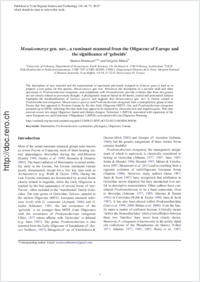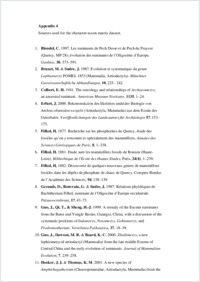Mosaicomeryx gen. nov., a ruminant mammal from the Oligocene of Europe and the significance of ‘gelocids’
- Mennecart, Bastien University of Fribourg, Department of Geosciences, Earth Sciences, Switzerland - CR2P, Paléobiodiversité et Paléoenvironnements, Département Histoire de la Terre, Muséum National d’Histoire Naturelle, Paris, France
- Métais, Grégoire CR2P, Paléobiodiversité et Paléoenvironnements, Département Histoire de la Terre, Muséum National d’Histoire Naturelle, Paris, France
-
03.07.2015
Published in:
- Journal of Systematic Palaeontology. - 2015, vol. 13, no. 7, p. 581–600
English
The description of new material and the reassessment of specimens previously assigned to Gelocus quercyi lead us to propose a new genus for this species, Mosaicomeryx gen. nov. Moreover, the description of a juvenile skull and other specimens of Prodremotherium elongatum, and comparison with Dremotherium, provide evidence that these two genera are not closely related as previously thought. A phylogenetic analysis based on 40 dental, cranial and postcranial features highlights the misidentification of Gelocus quercyi and suggests that Mosaicomeryx gen. nov. is closely related to Prodremotherium elongatum. Mosaicomeryx quercyi and Prodremotherium elongatum form a monophyletic group of stem Pecora that first appeared in Western Europe by the late Early Oligocene (MP25–26), and Prodremotherium elongatum persisted up to MP28; following this time both taxa appear to be replaced by Dremotherium and Amphitragulus. This time interval covers two major Oligocene faunal and climate changes: Extinction 1 (MP24), associated with regression of the inner European sea, and Extinction 3/Migrations 3 (MP28), associated with Late Oligocene Warming.
- Faculty
- Faculté des sciences et de médecine
- Department
- Département de Géosciences
- Language
-
- English
- Classification
- Palaeontology
- License
-
License undefined
- Identifiers
-
- RERO DOC 257202
- DOI 10.1080/14772019.2014.948505
- Persistent URL
- https://folia.unifr.ch/unifr/documents/304519
Other files
Statistics
Document views: 111
File downloads:
- pdf: 451
- Supplementary material: 143

